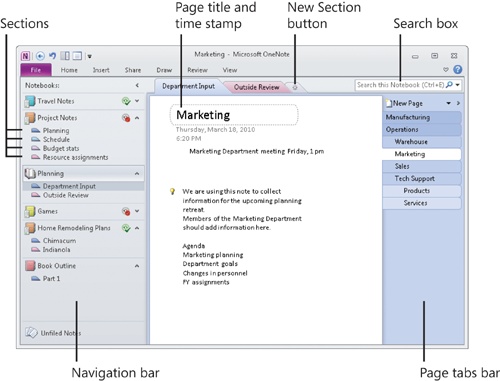In this book’s four chapters, you’ll build on the general skills required to create, manage, and share notebooks in Microsoft OneNote 2010. You’ll learn more about the specific skills you need to be certified as a Microsoft OneNote 2010 specialist. The areas covered are the following:
Manage the OneNote environment
Sharing and collaborating on notebooks
Organizing and finding notes
Editing and linking content in OneNote
The skills described in the following chapters cover many of the everyday operations you’ll perform when you work in OneNote, including how you create a notebook, share a notebook with other users, organize and search content, and edit and format notes and visual elements such as pictures and drawings. This section provides a brief introduction to OneNote by describing the main elements of a notebook and the elements of the OneNote user interface that you use most often.
OneNote notebooks can be used for any number of purposes—brainstorming sessions, class notes, compiling research, project task assignments and status, and many others. A notebook can contain various types of content—notes you type or write by hand, printouts from files, tables, screen shots, drawings, and pictures are examples.
A notebook contains at least one section, which OneNote includes by default when you create a notebook. You can create additional sections as you need them, and sections can be organized into section groups in a notebook with many sections. Sections contain pages. Pages are where you add notes, pictures, and other types of content. You can also create subpages to define a more detailed level of organization.
Each section in a notebook is saved in a separate file that uses the Microsoft OneNote Section format. These files include the file name extension .one. Section files are stored within a folder that uses the name you assign to a notebook when you create it. (You can change the display name of a notebook if you want to.) Section groups are stored in a subfolder of the notebook’s folder. A notebook’s folder also includes a file named OpenNotebook.onetoc2. You can double-click this file to open the notebook.
OneNote saves changes you make to a notebook automatically. You don’t need to click a Save button or a Save command before you close a notebook, for example.
The following illustration shows the main OneNote window. Open notebooks are listed on the Navigation bar, which appears along the left side of the OneNote window by default. The sections in a notebook are listed under the entry for a notebook in the Navigation bar. Click a section name to display that section. You can also display a section by clicking the section tab that appears across the top of the current page. The pages in a section are listed in the page tabs bar, which is shown along the right side of the window. You can also position the page tabs bar along the left side of the window. Click a page name to display its content. Click New Page at the top of the page tabs bar to insert another page in the section.

